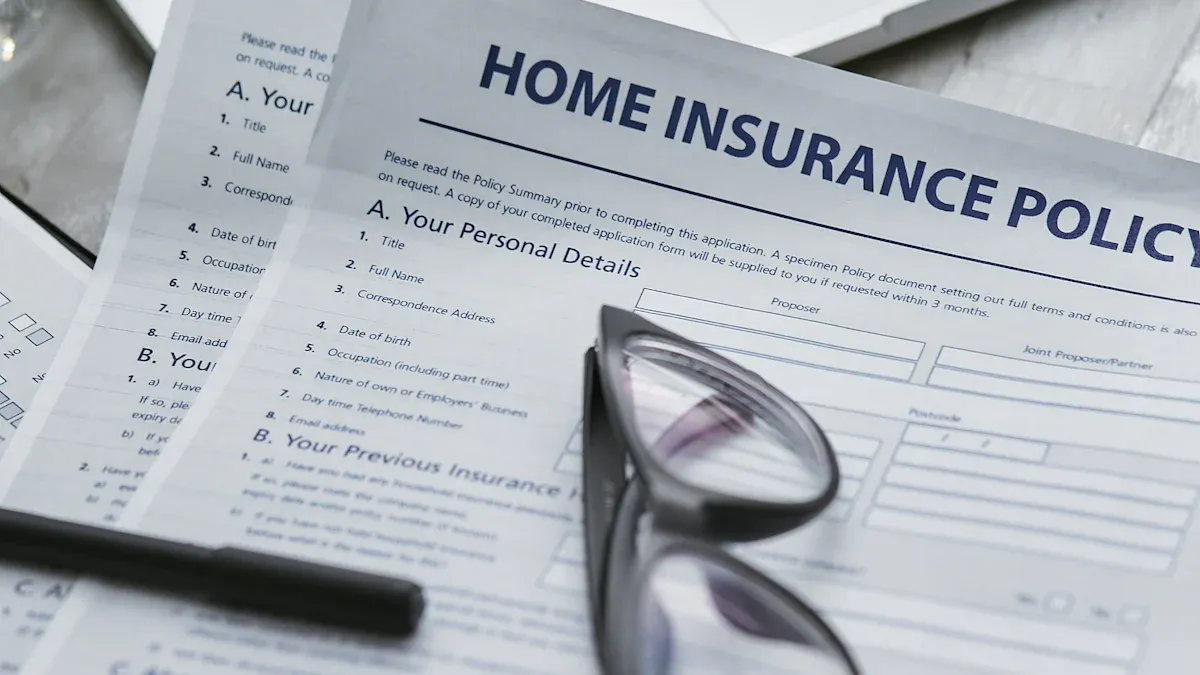Image Source: unsplash
Filing an insurance claim can feel overwhelming, but knowing the process makes all the difference. That’s why I recommend reading the ‘Complete Guide to the Insurance Claims Process: From Reporting to Payout.’ I’ve seen how understanding each step can help policyholders avoid costly mistakes. For example:
- Many don’t realize the first payment is often an advance, not the final settlement.
- Some receive multiple checks for different damages, which makes knowing your policy coverage crucial.
- Lenders may need to endorse checks, adding another layer of complexity.
When you understand these details, as outlined in the ‘Complete Guide to the Insurance Claims Process: From Reporting to Payout,’ you can save time, reduce stress, and ensure you get the payout you deserve.
Key Takeaways
- Report your claim quickly. Fast reporting helps start the process sooner.
- Keep detailed records. Save damage photos, receipts, and messages to support your claim.
- Learn your policy. Knowing coverage avoids confusion and helps get approval.
Overview of the Insurance Claims Process
Definition of an insurance claim
An insurance claim is your formal request to an insurer for compensation after a covered loss or event. It’s your way of activating the protection you’ve been paying for. Whether it’s a car accident, a house fire, or a medical emergency, filing a claim ensures you get the financial support you need. I always remind people that this step is crucial—it’s how you turn your policy into action.
Key stages in the claims process
The claims process might seem complicated, but breaking it down into steps makes it easier to understand. Here’s how it typically works:
- An event causes a loss, like a car accident or storm damage.
- You submit your claim to the insurance company.
- A claims examiner reviews your submission for completeness and checks if your policy covers the loss.
- A claims adjuster investigates the details of your claim.
- The claim moves through various stages of processing, with each step requiring approval before the payout.
Each stage builds on the last, so accuracy and timeliness are essential. I’ve seen how missing details or delays can slow everything down.
Importance of understanding the process
Knowing how the claims process works gives you a huge advantage. Here’s why:
- It helps you understand your rights and whether you can file a claim.
- Familiarity with the process increases the chances of your claim being accepted.
- Being prepared makes it easier to navigate the complexities of filing.
When you know what to expect, you can avoid surprises and stay in control. That’s why I always recommend reading resources like the Complete Guide to the Insurance Claims Process: From Reporting to Payout. It’s the best way to ensure you’re ready when the unexpected happens.
Step-by-Step Guide to Filing an Insurance Claim
Reporting the incident promptly
The first step in filing an insurance claim is reporting the incident as soon as possible. I always tell people not to delay this step. The faster you notify your insurer, the quicker they can start processing your claim. Most insurance companies have a 24/7 hotline or online portal for reporting incidents. Use these tools to your advantage. Provide accurate details about what happened, including the date, time, and location of the event. This ensures your claim gets off to a smooth start.
Tip: Keep your insurance policy number handy when reporting the incident. It speeds up the process and helps the insurer locate your account quickly.
Documenting losses and gathering evidence
Thorough documentation is key to a successful claim. I recommend using a systematic approach to gather evidence. Here’s what works best:
- Use Proof of Loss forms immediately after filing your claim.
- Take clear photographs of the damage and collect repair estimates.
- Submit sworn statements with your Proof of Loss to strengthen your case.
- Send documents as you collect them instead of waiting until the end.
- Include a cover letter explaining the purpose of each document.
This level of detail shows your insurer that you’re serious about your claim. It also helps avoid unnecessary delays.
Submitting required documentation
Submitting the right documents is critical. Based on my experience, missing paperwork can stall your claim. Here’s a checklist of commonly required documents:
- Insurance Policy Number
- Medical Bills
- Itemized Receipts
- Medical Records
- Prescription Documents
- Accident or Police Reports
- Disability Forms
- Travel Documents
- Personal Identification
Double-check everything before submission. This ensures your claim moves forward without hiccups.
Communicating effectively with your insurer
Clear communication with your insurer can make or break your claim. I’ve found that using the right strategies can simplify the process. Here’s a quick guide:
| Strategy | Description |
|---|---|
| Omnichannel Strategy | Engage through multiple digital channels for a seamless experience. |
| Personalization | Tailor your interactions to show you’re informed and prepared. |
| Simplification of Processes | Keep your requests straightforward to avoid confusion. |
| Chatbots and Conversational AI | Use these tools for quick answers to common questions. |
By staying proactive and organized, you can build a strong relationship with your insurer. This increases the likelihood of a favorable outcome.
Note: Always keep a record of your conversations, including dates and names of representatives you speak with.
The "Complete Guide to the Insurance Claims Process: From Reporting to Payout" emphasizes the importance of these steps. Following them ensures a smoother claims experience and maximizes your payout.
Claim Evaluation and Investigation Process
How insurers validate claims
Insurers use several methods to ensure claims are valid. I’ve seen how they rely on data analysis to detect patterns and anomalies. For example, they compare claims data with external sources like weather reports or public records. This helps them verify if the reported event aligns with reality. Technology plays a big role here. Many insurers use digital platforms and mobile apps to collect information. These tools often include AI and machine learning, which improve accuracy and reduce errors.
Another key step involves gathering information directly from policyholders and witnesses. Insurers investigate suspicious activities to prevent fraud. This process protects both the company and honest policyholders. I always tell people to provide accurate details during this stage. It builds trust and speeds up the process.
Role of adjusters in the process
Insurance adjusters are the backbone of the claims process. They evaluate claims by inspecting damages, reviewing medical records, and interviewing involved parties. Their goal is to determine the extent of coverage and resolve claims efficiently. Adjusters also play a critical role in preventing fraud. They ensure compliance with policy terms, which helps insurers manage costs. I’ve noticed that working cooperatively with adjusters can lead to better outcomes. Be transparent and provide all requested information promptly.
Factors influencing claim approval
Several factors determine whether a claim gets approved. The accuracy of your documentation is crucial. Insurers look for clear evidence that supports your claim. Policy terms also play a big role. If the event isn’t covered, the claim will likely be denied. I always advise people to review their policies carefully before filing a claim. Lastly, the insurer’s investigation findings can heavily influence the decision. Being honest and thorough increases your chances of approval.
The "Complete Guide to the Insurance Claims Process: From Reporting to Payout" highlights these steps to help you navigate the process successfully.
Payment Process and Types of Payouts

Image Source: pexels
How payouts are calculated
Understanding how insurers calculate payouts can help you set realistic expectations. I’ve seen insurers follow a structured process to determine the amount you’ll receive. They validate your claim submission, review supporting documents, and conduct investigations when necessary. Once they complete these steps, they decide whether to approve or deny your claim.
The type of claim also influences the calculation. For example:
- Travel claims cover mishaps like flight cancellations or illnesses.
- Health claims address medical expenses.
- Life insurance claims help with urgent costs like funeral arrangements.
- Property claims compensate for damages caused by natural disasters.
- Commercial property claims cover business interruptions.
Damage assessments depend on your policy and state laws. For instance, property owners must submit a proof of loss form and provide detailed evidence, such as photos of the damage. Policies may specify whether payouts are based on replacement value or actual cash value, which directly impacts the final amount.
Types of payouts: lump-sum vs. installments
When it comes to payouts, insurers typically offer two options: lump-sum payments or installments. I always recommend understanding the pros and cons of each. A lump-sum payment provides the entire amount at once, which is ideal for covering large, immediate expenses like medical bills or home repairs. On the other hand, installment payments spread the amount over time, making them suitable for ongoing costs like rehabilitation or long-term care.
Choosing the right option depends on your financial needs. I’ve found that discussing this with your insurer can help you make an informed decision.
Timeline for receiving payments
The timeline for receiving your payout varies based on the type of claim and the insurer’s processes. In my experience, straightforward claims, like minor property damage, often get resolved within a few weeks. However, complex claims, such as those involving extensive investigations, can take months.
To speed up the process, ensure all your documentation is accurate and complete. Insurers often delay payments due to missing or incorrect information. Staying proactive and following up regularly can also help. I always advise keeping a record of your communications to avoid unnecessary delays.
The "Complete Guide to the Insurance Claims Process: From Reporting to Payout" emphasizes the importance of understanding these timelines. Knowing what to expect can help you plan your finances effectively.
Common Challenges in the Insurance Claims Process
Delays in claim processing
Delays in claim processing frustrate many policyholders. I’ve seen how these delays can disrupt financial plans and create unnecessary stress. The most common reasons include:
- Requesting unnecessary documentation
- Frequent changes in claims adjusters
- Miscommunication between the insurer and the policyholder
- Delaying payment even after claim approval
- Alleging policy misinterpretation
To avoid these issues, I always recommend staying proactive. Submit all required documents promptly and double-check for accuracy. Follow up regularly with your insurer to ensure your claim progresses smoothly. Keeping detailed records of every interaction also helps resolve disputes faster.
Tip: If you notice delays, escalate the issue to a supervisor or file a formal complaint with your insurer.
Disputes over claim amounts
Disputes over claim amounts happen more often than you might think. I’ve seen policyholders struggle to get fair compensation because they didn’t know their options. If you find yourself in this situation, consider these steps:
- Appraisal: Request an appraisal to determine the scope and severity of the damage.
- Mediation: Use mediation for a faster and less expensive resolution.
- Litigation: File a lawsuit if necessary. This often leads to settlements before trial.
Each option has its pros and cons. I always advise starting with appraisal or mediation before considering litigation. These methods save time and money while still giving you a chance to negotiate a better outcome.
Denied claims and how to appeal
A denied claim doesn’t mean the end of the road. I’ve helped people successfully appeal denials by following a structured approach. Here’s what works:
- Review the denial notification carefully and call your insurer for clarification.
- Understand the appeals process and gather the necessary information.
- Submit your appeal promptly and keep detailed records of all communications.
- Seek professional help if the process feels overwhelming.
Persistence is key. Insurers often deny claims due to incomplete information or misinterpretation of policy terms. By staying organized and informed, you can turn a denial into an approval.
Note: Always document every step of the appeals process. This ensures you have evidence to support your case if needed.
Tips for a Smooth and Successful Claims Process
Keeping detailed records and evidence
I always stress the importance of keeping detailed records when filing an insurance claim. Accurate documentation can make or break your case. Start by creating a list of all damaged or lost items. Include receipts, photos, and any other proof of ownership. If you don’t have receipts, take clear photos of the damage and note the approximate value of each item. This shows your insurer that you’re prepared and organized.
Keep a log of every interaction with your insurance company. Write down the names of representatives, dates of conversations, and key points discussed. This record can help resolve disputes if any arise. I’ve seen how this simple habit can save time and prevent misunderstandings. Remember, the more evidence you provide, the stronger your claim becomes.
Avoiding common mistakes
Many policyholders make avoidable mistakes during the claims process. I’ve noticed these errors often lead to delays or denied claims. Here are some common pitfalls and how to avoid them:
- Not filing quickly: Report your claim as soon as possible. Most policies have strict deadlines for filing.
- Being disorganized: Keep an inventory of damaged items and document every step of the process.
- Relying solely on the insurer’s experts: Consider hiring your own appraiser or contractor for a second opinion.
- Misunderstanding your policy: Take time to review your policy’s terms and conditions before filing.
Avoiding these mistakes can significantly improve your chances of a smooth claims process.
Negotiating effectively with your insurer
Negotiation is a critical part of the claims process. I’ve found that being confident and well-prepared can lead to better outcomes. Start by understanding your policy thoroughly. Know what’s covered and what isn’t. This knowledge gives you a solid foundation for discussions.
When negotiating, remain calm and professional. Present your evidence clearly and explain why you believe your claim deserves full compensation. If the initial offer seems too low, don’t hesitate to push back. I’ve seen policyholders successfully negotiate higher payouts by providing additional documentation or seeking third-party evaluations. Persistence pays off, so don’t settle for less than what you’re entitled to.
Tip: Always communicate in writing when negotiating. This creates a paper trail that can protect you if disputes arise.
The insurance claims process becomes manageable when you follow these steps:
- Report and register your claim.
- Provide accurate documentation.
- Cooperate during investigations.
- Negotiate settlements confidently.
- Track payments and closure.
Stay proactive. Understand your policy and responsibilities. Always aim to restore your property to its original condition. This approach ensures a smoother experience and maximizes your payout.
Tip: Be involved in repairs and maintain realistic expectations to avoid surprises.
FAQ
What should I do if my claim gets denied?
If your claim gets denied, don’t panic. Review the denial letter carefully. Gather additional evidence, and file an appeal promptly. Persistence often leads to successful outcomes.
Tip: Seek professional advice if the appeals process feels overwhelming. Experts can guide you through the steps and improve your chances of approval.
How long does the insurance claims process usually take?
The timeline varies. Simple claims may resolve in weeks, while complex ones can take months. Providing accurate documentation and following up regularly speeds up the process.
Can I negotiate the payout amount with my insurer?
Yes, you can negotiate. Present strong evidence, like repair estimates or appraisals, to support your case. Stay calm and professional during discussions to achieve better results.
Note: Always communicate in writing to create a record of your negotiations. This protects your interests if disputes arise.




